Energy Consumption and Environmental Impact of E-Grocery: A Systematic Literature Review
Abstract
1. Introduction
2. Methodology
3. Results
3.1. Papers Per Year, Country, and Channel
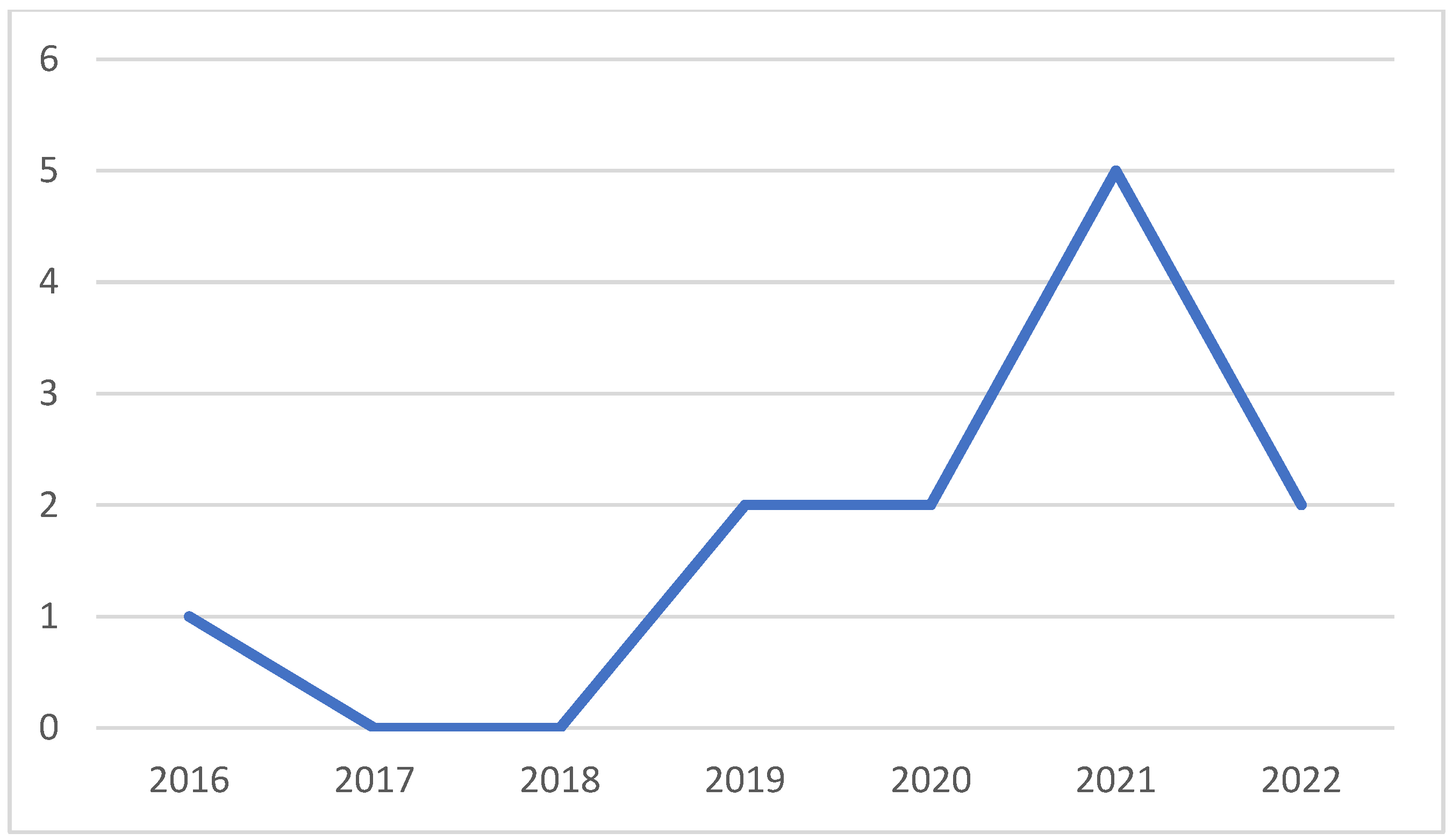
3.2. Influencing Factors Per Paper
3.3. Emissions and Energy Consumption
3.4. Gaps Analysis and Future Research Agenda
- a.
- Gaps analysis
- b.
- Future research agenda
4. Conclusions
Author Contributions
Funding
Institutional Review Board Statement
Informed Consent Statement
Data Availability Statement
Conflicts of Interest
References
- Tomoya Kawasaki, H.W.R.S. The use of e-commerce and the COVID-19 outbreak: A panel data analysis in Japan. Transp. Policy 2022, 115, 88–100. [Google Scholar] [CrossRef]
- Honey-Rosés, J.; Anguelovski, I.; Chireh, V.K.; Daher, C.; Konijnendijk van den Bosch, C.; Litt, J.S.; Mawani, V.; McCall, M.K.; Orellana, A.; Oscilowicz, E.; et al. The impact of COVID-19 on public space: An early review of the emerging questions—Design, perceptions and inequities. Cities Health 2020, 5, S263–S279. [Google Scholar] [CrossRef]
- Migliaccio, M.; Buono, A.; Maltese, I.; Migliaccio, M. The 2020 Italian Spring Lockdown: A Multidisciplinary Analysis over the Milan Urban Area. World 2021, 2, 391–414. [Google Scholar] [CrossRef]
- Shamshiripour, A.; Rahimi, E.; Shabanpour, R.; Mohammadian, A. (Kouros) How is COVID-19 reshaping activity-travel behavior? Evidence from a comprehensive survey in Chicago. Transp. Res. Interdiscip. Perspect. 2020, 7, 100216. [Google Scholar] [CrossRef]
- Grashuis, J.; Skevas, T.; Segovia, M.S. Grocery shopping preferences during the COVID-19 pandemic. Sustainability 2020, 12, 5369. [Google Scholar] [CrossRef]
- Bhaduri, E.; Manoj, B.S.; Wadud, Z.; Goswami, A.K.; Choudhury, C.F. Modelling the effects of COVID-19 on travel mode choice behaviour in India. Transp. Res. Interdiscip. Perspect. 2020, 8, 100273. [Google Scholar] [CrossRef]
- Friesen, C.A. Shopping for Food During COVID-19 Pandemic. J. Nutr. Educ. Behav. 2020, 52, 1082–1083. [Google Scholar] [CrossRef]
- Alaimo, L.S.; Fiore, M.; Galati, A. How the COVID-19 pandemic is changing online food shopping human behaviour in Italy. Sustainability 2020, 12, 9596. [Google Scholar] [CrossRef]
- Chen, J.; Zhang, Y.; Zhu, S.; Liu, L. Does covid-19 affect the behavior of buying fresh food? Evidence from Wuhan, China. Int. J. Environ. Res. Public Health 2021, 18, 4469. [Google Scholar] [CrossRef]
- Agnihotri, A. Can Brick-and-Mortar Retailers Successfully Become Multichannel Retailers? J. Mark. Channels 2015, 22, 62–73. [Google Scholar] [CrossRef]
- Piroth, P.; Rüger-Muck, E.; Bruwer, J. Digitalisation in grocery retailing in Germany: An exploratory study. Int. Rev. Retail. Distrib. Consum. Res. 2020, 30, 479–497. [Google Scholar] [CrossRef]
- Hajdas, M.; Radomska, J.; Silva, S.C. The omni-channel approach: A utopia for companies? J. Retail. Consum. Serv. 2022, 65, 102131. [Google Scholar] [CrossRef]
- Handayani, P.W.; Nurahmawati, R.A.; Pinem, A.A.; Azzahro, F. Switching Intention from Traditional to Online Groceries Using the Moderating Effect of Gender in Indonesia. J. Food Prod. Mark. 2020, 26, 425–439. [Google Scholar] [CrossRef]
- Habib, S.; Hamadneh, N.N. Impact of perceived risk on consumers technology acceptance in online grocery adoption amid covid-19 pandemic. Sustainability 2021, 13, 10221. [Google Scholar] [CrossRef]
- Haridasan, A.C.; Fernando, A.G. Online or in-store: Unravelling consumer’s channel choice motives. J. Res. Interact. Mark. 2018, 12, 215–230. [Google Scholar] [CrossRef]
- Frank, D.A.; Peschel, A.O. Sweetening the Deal: The Ingredients that Drive Consumer Adoption of Online Grocery Shopping. J. Food Prod. Mark. 2020, 26, 535–544. [Google Scholar] [CrossRef]
- Cervellon, M.C.; Sylvie, J.; Ngobo, P.V. Shopping orientations as antecedents to channel choice in the French grocery multichannel landscape. J. Retail. Consum. Serv. 2015, 27, 31–51. [Google Scholar] [CrossRef]
- Tsai, C.A.; Chang, C.W. Development of a Partial Shipping Fees Pricing Model to Influence Consumers’ Purchase Intention under the COVID-19 Pandemic. Energies 2022, 15, 1846. [Google Scholar] [CrossRef]
- Nowlan, A.; Fine, J.; O’connor, T.; Burget, S. Pollution accounting for corporate actions: Quantifying the air emissions and impacts of transportation system choices case study: Food freight and the grocery industry in los angeles. Sustainability 2021, 13, 10194. [Google Scholar] [CrossRef]
- Marcucci, E.; Gatta, V.; Bråthen, S. E-groceries, digitalization and sustainability. Res. Transp. Econ. 2021, 87, 101097. [Google Scholar] [CrossRef]
- Sernicola, F.; Maltese, I.; Gatta, V.; Iannaccone, G.; Marcucci, E. Impatto del lockdown sulla spesa degli italiani: Quale futuro per l’e-grocery? Riv. Sci. della Soc. Ital. di Econ. Dei Trasp. E della Logist. 2020, 3, 1–13. Available online: https://www.openstarts.units.it/handle/10077/32169 (accessed on 27 July 2022).
- Bjørgen, A.; Bjerkan, K.Y.; Hjelkrem, O.A. E-groceries: Sustainable last mile distribution in city planning. Res. Transp. Econ. 2021, 87, 100805. [Google Scholar] [CrossRef]
- Bjørgen, A.; Ryghaug, M. Integration of urban freight transport in city planning: Lesson learned. Transp. Res. Part D Transp. Environ. 2022, 107, 103310. [Google Scholar] [CrossRef]
- Maltese, I.; Mariotti, I.; Boscacci, F. Smart City, Urban Performance and Energy. In Smart Energy in the Smart City Urban Planning for a Sustainable Future; Springer: Berlin/Heidelberg, Germany, 2016; pp. 25–42. ISBN 978-3-319-31157-9. [Google Scholar]
- Patella, S.M.; Grazieschi, G.; Gatta, V.; Marcucci, E.; Carrese, S. The adoption of green vehicles in last mile logistics: A systematic review. Sustainability 2021, 13, 6. [Google Scholar] [CrossRef]
- Maltese, I.; Gatta, V.; Marcucci, E. Active Travel in Sustainable Urban Mobility Plans. An Italian overview. Res. Transp. Bus. Manag. 2021, 40, 100621. [Google Scholar] [CrossRef]
- Arnold, F.; Cardenas, I.; Sörensen, K.; Dewulf, W. Simulation of B2C e-commerce distribution in Antwerp using cargo bikes and delivery points. Eur. Transp. Res. Rev. 2018, 10, 2. [Google Scholar] [CrossRef]
- Gatta, V.; Marcucci, E.; Nigro, M.; Patella, S.M.; Serafini, S. Public transport-based crowdshipping for sustainable city logistics: Assessing economic and environmental impacts. Sustainability 2019, 11, 145. [Google Scholar] [CrossRef]
- Milewski, D.; Milewska, B. The energy efficiency of the last mile in the E-commerce distribution in the context the COVID-19 pandemic. Energies 2021, 14, 7836. [Google Scholar] [CrossRef]
- Pani, A.; Mishra, S.; Golias, M.; Figliozzi, M. Evaluating Public Acceptance of Autonomous Delivery Robots During COVID-19 Pandemic. Transp. Res. Part D Transp. Environ. 2020, 89, 102600. [Google Scholar] [CrossRef]
- Kochańska, E.; Łukasik, R.M.; Dzikuć, M. New circular challenges in the development of take-away food packaging in the covid-19 period. Energies 2021, 14, 4705. [Google Scholar] [CrossRef]
- Baldev Sandhu, E.A.; Hanus, G. A Systematic Review on Consumer’s Behaviour for Online Grocery Shopping. Irjet 2016, 8, 639–644. [Google Scholar]
- Annadate, P.; Mude, G. Online Grocery Industry in India: Identifying Key Themes and Future Directions through a Literature Review. IIM Kozhikode 2020, 4, 1–4. [Google Scholar]
- Prabowo, H. Online Grocery Shopping Adoption: A Systematic Literature Review. In Proceedings of the 2020 International Conference on Information Management and Technology (ICIMTech), Bandung, Indonesia, 13–14 August 2020; pp. 40–45. [Google Scholar]
- Hänninen, M.; Kwan, S.K.; Mitronen, L. From the store to omnichannel retail: Looking back over three decades of research. Int. Rev. Retail. Distrib. Consum. Res. 2021, 31, 1–35. [Google Scholar] [CrossRef]
- Lagorio, A.; Pinto, R. Food and grocery retail logistics issues: A systematic literature review. Res. Transp. Econ. 2021, 87, 100841. [Google Scholar] [CrossRef]
- Martín, J.C.; Pagliara, F.; Román, C. The research topics on e-grocery: Trends and existing gaps. Sustainability 2019, 11, 321. [Google Scholar] [CrossRef]
- Page, M.J.; McKenzie, J.E.; Bossuyt, P.M.; Boutron, I.; Hoffmann, T.C.; Mulrow, C.D.; Shamseer, L.; Tetzlaff, J.M.; Akl, E.A.; Brennan, S.E.; et al. The PRISMA 2020 statement: An updated guideline for reporting systematic reviews. BMJ 2021, 372, 89. [Google Scholar] [CrossRef]
- Davis, J.; Mengersen, K.; Bennett, S.; Mazerolle, L. Viewing systematic reviews and meta-analysis in social research through different lenses. Springerplus 2014, 3, 511. [Google Scholar] [CrossRef]
- Zeng, Y.; Jia, F.; Wan, L.; Guo, H. E-commerce in agri-food sector: A systematic literature review. Int. Food Agribus. Manag. Rev. 2017, 20, 439–459. [Google Scholar] [CrossRef]
- Apostolopoulos, N.; Ratten, V.; Petropoulos, D.; Liargovas, P.; Anastasopoulou, E. Agri-food sector and entrepreneurship during the COVID-19 crisis: A systematic literature review and research agenda. Strateg. Chang. 2021, 30, 159–167. [Google Scholar] [CrossRef]
- Barth, H.; Ulvenblad, P.O.; Ulvenblad, P. Towards a conceptual framework of sustainable business model innovation in the agri-food sector: A systematic literature review. Sustainability 2017, 9, 1620. [Google Scholar] [CrossRef]
- Michel-Villarreal, R.; Hingley, M.; Canavari, M.; Bregoli, I. Sustainability in Alternative Food Networks: A systematic literature review. Sustainability 2019, 11, 859. [Google Scholar] [CrossRef]
- Shroff, A.; Shah, B.J.; Gajjar, H. Online food delivery research: A systematic literature review. Int. J. Contemp. Hosp. Manag. 2022, 34, 2852–2883. [Google Scholar] [CrossRef]
- Page, M.J.; Moher, D.; Bossuyt, P.M.; Boutron, I.; Hoffmann, T.C.; Mulrow, C.D.; Shamseer, L.; Tetzlaff, J.M.; Akl, E.A.; Brennan, S.E.; et al. PRISMA 2020 explanation and elaboration: Updated guidance and exemplars for reporting systematic reviews. BMJ 2021, 372, n160. [Google Scholar] [CrossRef]
- Okoli, C. A guide to conducting a standalone systematic literature review. Commun. Assoc. Inf. Syst. 2015, 37, 879–910. [Google Scholar] [CrossRef]
- Kitchenham, B.; Charters, S. Guidelines for Performing Systematic Literature Reviews in Software Engineering; EBSE Technical Report EBSE-2007-01, 2007. Available online: https://www.elsevier.com/__data/promis_misc/525444systematicreviewsguide.pdf (accessed on 27 July 2022).
- Bandara, W.; Furtmueller, E.; Gorbacheva, E.; Miskon, S.; Beekhuyzen, J. Achieving rigor in literature reviews: Insights from qualitative data analysis and tool-support. Commun. Assoc. Inf. Syst. 2015, 37, 154–204. [Google Scholar] [CrossRef]
- Campo, K.; Breugelmans, E. Buying Groceries in Brick and Click Stores: Category Allocation Decisions and the Moderating Effect of Online Buying Experience. J. Interact. Mark. 2015, 31, 63–78. [Google Scholar] [CrossRef]
- Roger, S. Global E-Commerce Grocery Market Has Grown 15% to 48bn. Kantar World Panel. 2016. Available online: https://www.kantarworldpanel.com/global/News/Global-e-commerce-grocery-market-has-grown-15-to-48bn (accessed on 27 July 2022).
- Seitz, C.; Pokrivčák, J.; Tóth, M.; Plevný, M. Online grocery retailing in Germany: An explorative analysis. J. Bus. Econ. Manag. 2017, 18, 1243–1263. [Google Scholar] [CrossRef]
- National Climate Policy. National Climate Policy. 2017. Available online: https://www.bmuv.de/en/topics/climate-adaptation/climate-protection/national-climate-policy#:~:text=Germany has set itself ambitious targets for reducing emissions%2C for,to 95 percent by 2050 (accessed on 27 July 2022).
- Climate and Energy. Climate and Energy. 2022. Available online: https://www.tatsachen-ueber-deutschland.de/en/climate-and-energy (accessed on 27 July 2022).
- Wygonik, E.; Goodchild, A. Evaluating the Efficacy of Shared-use Vehicles for Reducing Greenhouse Gas Emissions: A U.S. Case Study of Grocery Delivery. J. Transp. Res. Forum 2012, 51, 111–126. [Google Scholar] [CrossRef]
- Daniels, J. Online Grocery Sales Set to Surge, Grabbing 20 Percent of Market by 2025. 2017. Available online: https://www.cnbc.com/2017/01/30/online-grocery-sales-set-surge-grabbing-20-percent-of-market-by-2025.html (accessed on 27 July 2022).
- Panzone, L.A.; Ulph, A.; Hilton, D.; Gortemaker, I.; Tajudeen, I.A. Sustainable by Design: Choice Architecture and the Carbon Footprint of Grocery Shopping. J. Public Policy Mark. 2021, 40, 463–486. [Google Scholar] [CrossRef]
- Leyerer, M.; Sonneberg, M.O.; Heumann, M.; Breitner, M.H. Shortening the last mile in urban areas: Optimizing a smart logistics concept for e-grocery operations. Smart Cities 2020, 3, 585–603. [Google Scholar] [CrossRef]
- Hardi, L.; Wagner, U. Grocery delivery or customer pickup-influences on energy consumption and CO2 emissions in Munich. Sustainability 2019, 11, 641. [Google Scholar] [CrossRef]
- Wang, X.; Zhang, S.; Schneider, N. Evaluating the carbon emissions of alternative food provision systems: A comparative analysis of recipe box and supermarket equivalents. Technol. Forecast. Soc. Chang. 2021, 173, 121099. [Google Scholar] [CrossRef]
- Gee, I.M.; Davidson, F.T.; Speetles, B.L.; Webber, M.E. Deliver Me from food waste: Model framework for comparing the energy use of meal-kit delivery and groceries. J. Clean. Prod. 2019, 236, 117587. [Google Scholar] [CrossRef]
- Brand, C.; Schwanen, T.; Anable, J. ‘ Online Omnivores ’ or ‘ Willing but struggling ’ ? Identifying online grocery shopping behavior segments using attitude theory. J. Retail. Consum. Serv. 2020, 57, 102195. [Google Scholar] [CrossRef]
- Blitstein, J.L.; Frentz, F.; Jilcott Pitts, S.B. A Mixed-method Examination of Reported Benefits of Online Grocery Shopping in the United States and Germany: Is Health a Factor? J. Food Prod. Mark. 2020, 26, 212–224. [Google Scholar] [CrossRef]
- Gatta, V.; Marcucci, E.; Maltese, I.; Iannaccone, G.; Fan, J. E-groceries: A channel choice analysis in shanghai. Sustainability 2021, 13, 3625. [Google Scholar] [CrossRef]
- De Magalhães, D.J.A.V. Analysis of critical factors affecting the final decision-making for online grocery shopping. Res. Transp. Econ. 2021, 87, 101088. [Google Scholar] [CrossRef]
- Maltese, I.; Le Pira, M.; Marcucci, E.; Gatta, V.; Evangelinos, C. Grocery or @grocery: A stated preference investigation in Rome and Milan. Res. Transp. Econ. 2021, 87, 101096. [Google Scholar] [CrossRef]
- Chu, J.; Arce-Urriza, M.; Cebollada-Calvo, J.J.; Chintagunta, P.K. An Empirical Analysis of Shopping Behavior Across Online and Offline Channels for Grocery Products: The Moderating Effects of Household and Product Characteristics. J. Interact. Mark. 2010, 24, 251–268. [Google Scholar] [CrossRef]
- Campo, K.; Lamey, L.; Breugelmans, E.; Melis, K. Going Online for Groceries: Drivers of Category-Level Share of Wallet Expansion. J. Retail. 2020, 97, 154–172. [Google Scholar] [CrossRef]
- Chintagunta, P.K.; Chu, J.; Cebollada, J. Quantifying transaction costs in online/off-line grocery channel choice. Mark. Sci. 2012, 31, 96–114. [Google Scholar] [CrossRef]
- Heldt, B.; Matteis, T.; von Schmidt, A.; Heinrichs, M. Cool but dirty food?—Estimating the impact of grocery home delivery on transport and CO2 emissions including cooling. Res. Transp. Econ. 2021, 87, 100763. [Google Scholar] [CrossRef]
- Figliozzi, M.A. Carbon emissions reductions in last mile and grocery deliveries utilizing air and ground autonomous vehicles. Transp. Res. Part D Transp. Environ. 2020, 85, 102443. [Google Scholar] [CrossRef]
- Siragusa, C.; Tumino, A. E-grocery: Comparing the environmental impacts of the online and offline purchasing processes. Int. J. Logist. Res. Appl. 2021, 25, 1164–1190. [Google Scholar] [CrossRef]
- Belavina, E.; Girotra, K.; Kabra, A. Online grocery retail: Revenue models and environmental impact. Manag. Sci. 2017, 63, 1781–1799. [Google Scholar] [CrossRef]
- Motte-Baumvol, B.; Chevallier, L.B.; Bonin, O. Does e-grocery shopping reduce CO2 emissions for working couples’ travel in England? Int. J. Sustain. Transp. 2022, 1–12. [Google Scholar] [CrossRef]
- Marcucci, E.; Gatta, V.; Le Pira, M.; Chao, T.; Li, S. Bricks or clicks? Consumer channel choice and its transport and environmental implications for the grocery market in Norway. Cities 2021, 110, 103046. [Google Scholar] [CrossRef]
- Aziz, S.; Gatta, V.; Marcucci, E.; Benmoussa, R.; Irhirane, E.H. E-grocery behavioural analysis for Sustainable Urban Logistics in Morocco. Int. J. Transp. Econ. 2022, XLIX, 9–32. [Google Scholar]
- Campbell, M.; McKenzie, J.E.; Sowden, A.; Katikireddi, S.V.; Brennan, S.E.; Ellis, S.; Hartmann-Boyce, J.; Ryan, R.; Shepperd, S.; Thomas, J.; et al. Synthesis without meta-analysis (SWiM) in systematic reviews: Reporting guideline. BMJ 2020, 368, l6890. [Google Scholar] [CrossRef]
- McKenzie, J.E.; Brennan, S.E. Chapter 12: Synthesizing and Presenting Findings Using Other Methods. Cochrane Handbook. 2022. Available online: https://training.cochrane.org/handbook/current/chapter-12 (accessed on 27 July 2022).
- Mortimer, G.; Mortimer, G.; Fazal, S.; Andrews, L.; Martin, J.; Mortimer, G.; Fazal, S.; Andrews, L.; Martin, J. Online grocery shopping: The impact of shopping frequency on perceived risk. Int. Rev. Retail. Distrib. Consum. Res. 2016, 26, 202–223. [Google Scholar] [CrossRef]
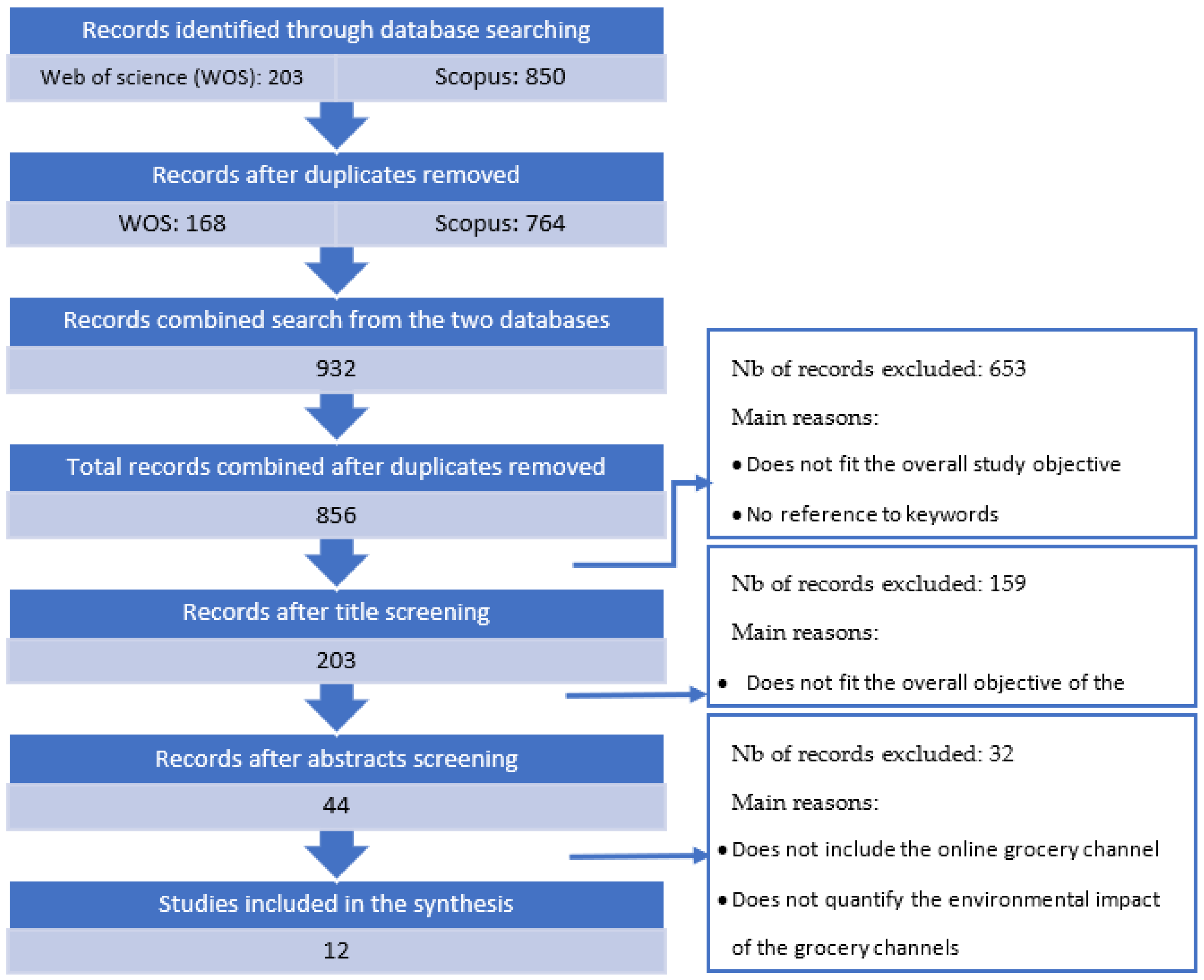
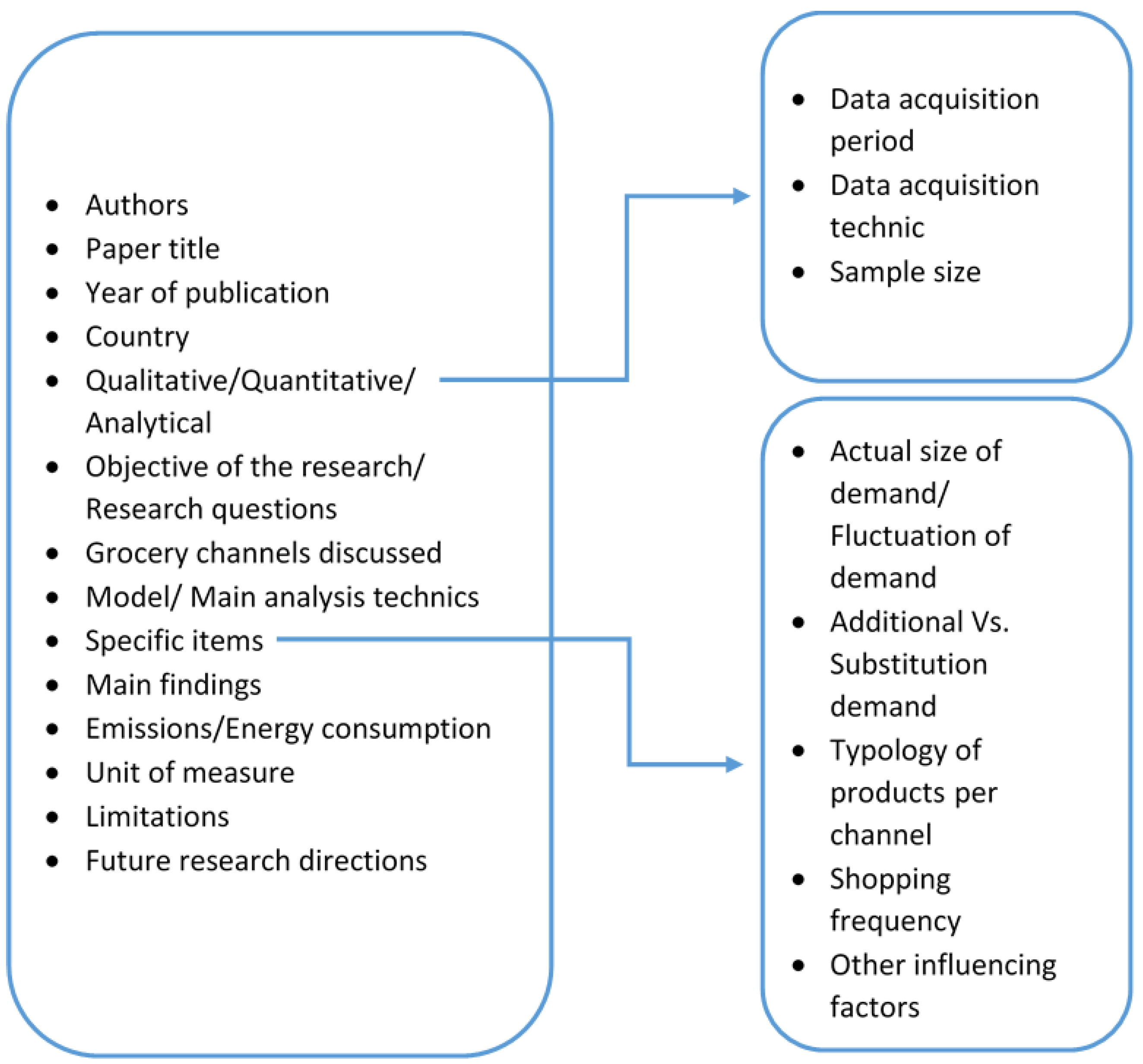
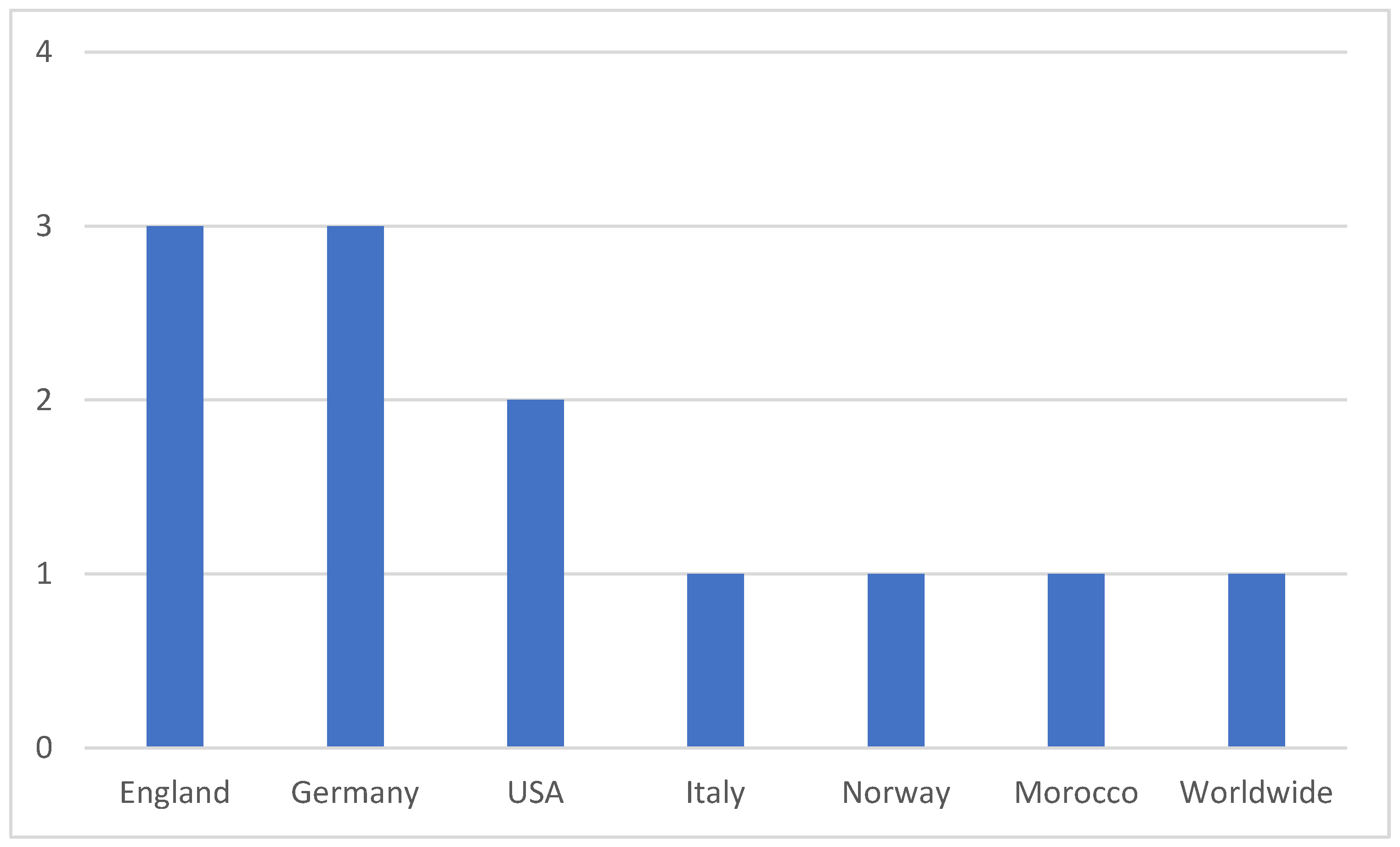
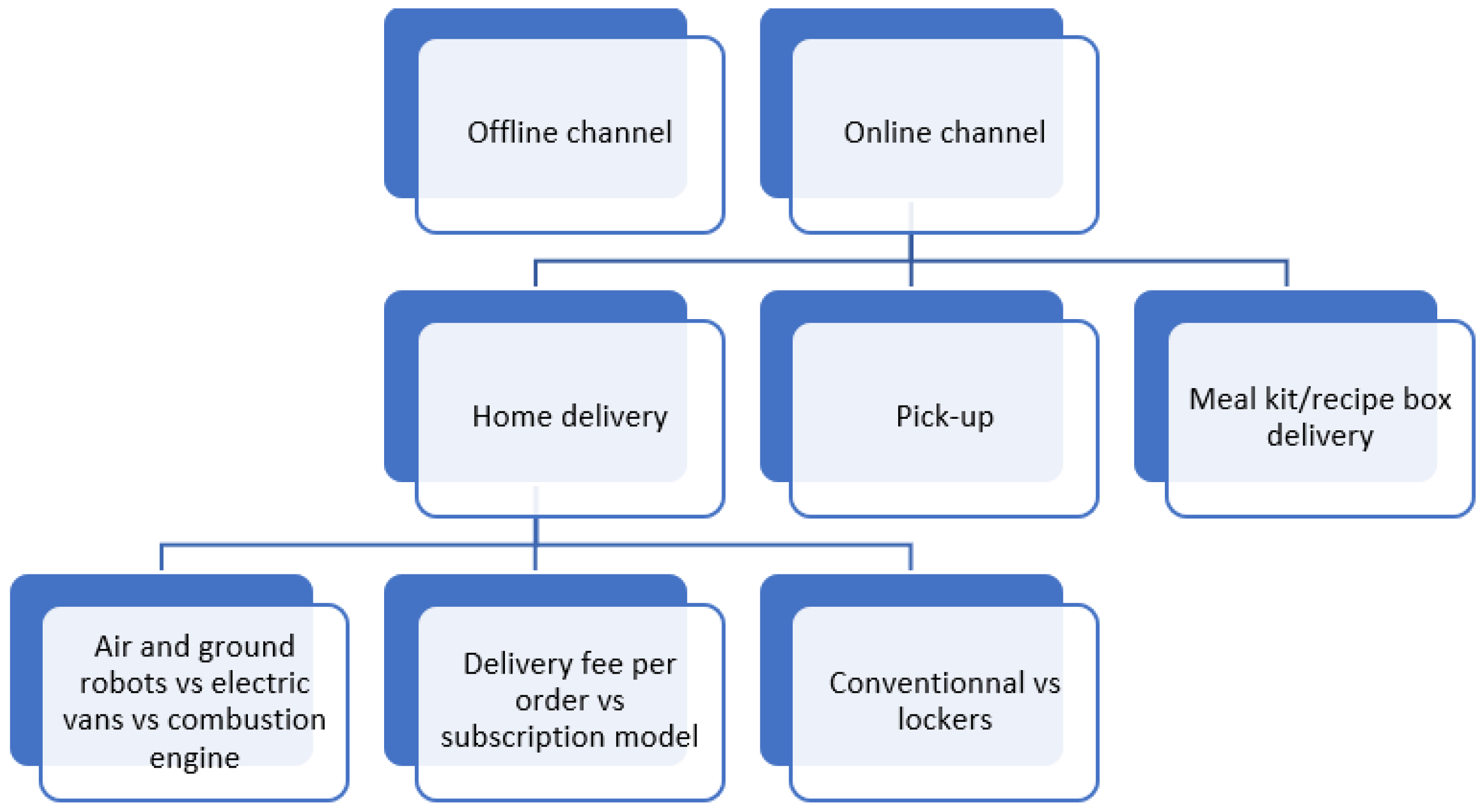
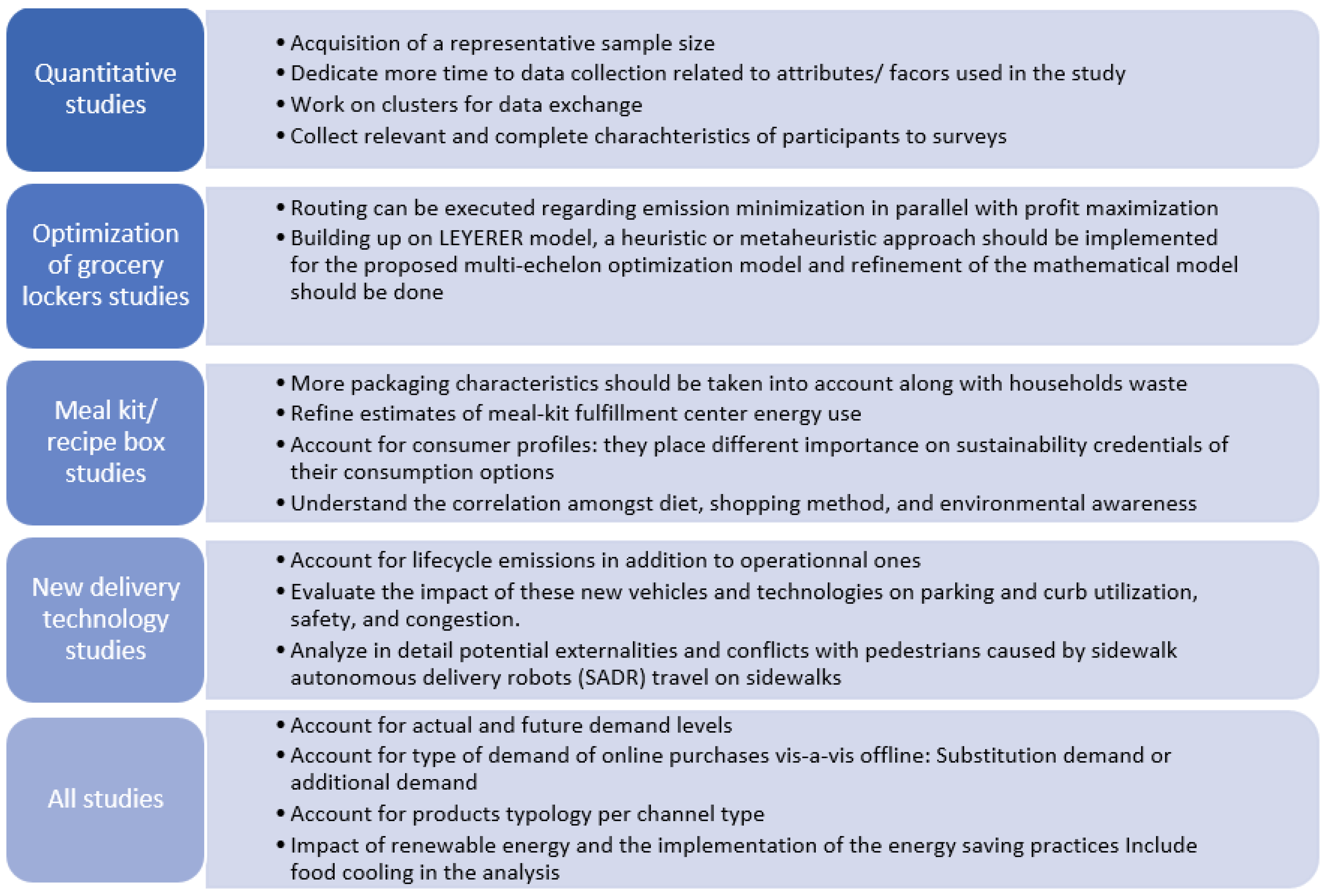
| Authors | Article Title | Actual Size of Demand/Fluctuation of Demand | Additional vs. Substitution Demand | Typology of Products | Shopping Frequency | Other Influencing Factors |
|---|---|---|---|---|---|---|
| [56] | Sustainable by Design: Choice Architecture and the Carbon Footprint of Grocery Shopping | Demand not taken into account/No sensitivity analysis conducted | No comparison of online and offline | Not taken into consideration | Not taken into consideration | Moral goal priming/Bonus-malus carbon tax |
| [60] | Deliver Me from food waste: Model framework for comparing the energy use of meal-kit delivery and groceries | Actual size of demand/No sensitivity analysis conducted | Substitution demand | Not taken into consideration | Not taken into consideration | Packaging |
| [59] | Evaluating the carbon emissions of alternative food provision systems: A comparative analysis of recipe box and supermarket equivalents | Demand not taken into account/sensitivity analysis conducted regarding different values of food loss/waste for each ingredient and relevant packaging materials | Substitution demand | Not taken into consideration | Not taken into consideration | Cooking and packaging related emissions |
| [58] | Grocery Delivery or Customer Pickup-Influences on Energy Consumption and CO2 Emissions in Munich | Study based on fluctuation of demand | Substitution demand | Not taken into consideration | Not taken into consideration | Combustion engine vs. electric vehicles |
| [69] | Cool but dirty food?—Estimating the impact of grocery home delivery on transport and CO2 emissions including cooling | Study based on fluctuation of demand | Substitution demand | Not taken into consideration | Partially taken into consideration | Cooling while delivering groceries/Different air temperature |
| [70] | Carbon emissions reductions in last mile and grocery deliveries utilizing air and ground autonomous vehicles | Calculations based on approximation/Sensitivity analysis conducted regarding other factors | No specification | Not taken into consideration | Not taken into consideration | Delivery service area, Service area to depot distance, Time to deliver, Nb customers, Customer travelled distance |
| [71] | E-grocery: comparing the environmental impacts of the online and offline purchasing processes | Actual size of demand taken into account/Sensitivity analysis conducted regarding travelled distances and basket size | No specification | Not taken into consideration | Not taken into consideration | All phases: replenishment, pre-sale and sale, picking/assembly, delivery and post-sale. |
| [57] | Shortening the Last Mile in Urban Areas: Optimizing a Smart Logistics Concept for E-Grocery Operations | Actual size of demand taken into account/Sensitivity analysis conducted | Substitution demand | Three product types (frozen, refrigerated, and dry products) discussed | Not taken into consideration | Delivery by electric cargo bicycles (ECBs); Grocery lockers locations |
| [72] | Online Grocery Retail: Revenue Models and Environmental Impact | Actual size of demand taken into account/Sensitivity analysis regarding demand vs. CO2 emissions was conducted | Partial substitution | Perishable products discussed | Taken into consideration | Subscription delivery model vs. per order one revenue model |
| [73] | Does e-grocery shopping reduce CO2 emissions for working couples’ travel in England? | Actual size of demand taken into account/No sensitivity analysis conducted | Substitution demand | Perishable products discussed | Taken into consideration | Gender |
| [74] | Bricks or clicks? Consumer channel choice and its transport and environmental implications for the grocery market in Norway | Actual size of demand taken into account/Sensitivity analysis conducted | Substitution demand | Not taken into consideration | Not taken into consideration | Product price, Service cost, Product range, Time window, Lead time, Travel time |
| [75] | E-grocery behavioural analysis for Sustainable Urban Logistics in Morocco | Actual size of demand taken into account/Sensitivity analysis conducted | Substitution demand | Not taken into consideration | Not taken into consideration | Product price, Service cost, Product range, Time window, Lead time, Travel time |
Publisher’s Note: MDPI stays neutral with regard to jurisdictional claims in published maps and institutional affiliations. |
© 2022 by the authors. Licensee MDPI, Basel, Switzerland. This article is an open access article distributed under the terms and conditions of the Creative Commons Attribution (CC BY) license (https://creativecommons.org/licenses/by/4.0/).
Share and Cite
Aziz, S.; Maltese, I.; Marcucci, E.; Gatta, V.; Benmoussa, R.; Irhirane, E.H. Energy Consumption and Environmental Impact of E-Grocery: A Systematic Literature Review. Energies 2022, 15, 7289. https://doi.org/10.3390/en15197289
Aziz S, Maltese I, Marcucci E, Gatta V, Benmoussa R, Irhirane EH. Energy Consumption and Environmental Impact of E-Grocery: A Systematic Literature Review. Energies. 2022; 15(19):7289. https://doi.org/10.3390/en15197289
Chicago/Turabian StyleAziz, Soukaina, Ila Maltese, Edoardo Marcucci, Valerio Gatta, Rachid Benmoussa, and El Hassan Irhirane. 2022. "Energy Consumption and Environmental Impact of E-Grocery: A Systematic Literature Review" Energies 15, no. 19: 7289. https://doi.org/10.3390/en15197289
APA StyleAziz, S., Maltese, I., Marcucci, E., Gatta, V., Benmoussa, R., & Irhirane, E. H. (2022). Energy Consumption and Environmental Impact of E-Grocery: A Systematic Literature Review. Energies, 15(19), 7289. https://doi.org/10.3390/en15197289






